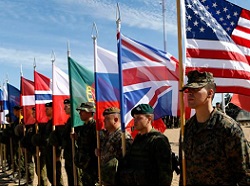Rachel Douglas
8 September 2016.
The Arctic battlefield or cooperation?
In a memo to the graph S. Yu, “On the study of the Arctic ocean”, dated 14 November 1901, D. I. Mendeleyev wrote about the route that is today called the Northern sea route (Sevmorput): “the Expedition filled by Peter the Great under the command of Bering — mankind owes the discovery of the Strait that separates the Old world from the New and connecting the Great ocean from the Arctic, where Russian Cossacks and Industrialists have long sailed the coast. Here are the beginning attempts of the glorious eighteenth and nineteenth centuries — to find a northeast or Northwest passage from the Atlantic to the Pacific, to connect the two shortest waterway of the Northern half of the globe, just as it is in the high latitudes in the southern half of the earth… to Defeat the polar ice ought, and is especially desirable for direct industrial use of mankind, the same, at least as celebrations of knowledge.”
Mendeleev wanted to lead an expedition to the Arctic. He believed the reduction of sea routes one way of advancing civilization and industry, including the development of Russian coast of the Arctic ocean.
Even before the acquisition by the United States of America the Arctic coast with the purchase of Alaska (1867), the prospect of Arctic exploration was inspired by American researchers. Suffice it to mention the project Perry Collins (the same who, in 1856, the year was a guest of the Governor-General of Eastern Siberia N. N. Muravyov-Amur) in the early 1860-ies on the establishment of Telegraph lines of the United States to Moscow, through the Bering Strait.
During the space age the problem posed by Mendeleev, the need to expand in accordance with the role of man as a citizen of the Solar system. The Arctic not only binds the two halves of the globe, it is for humanity a “window into space”, a laboratory for studying climate and weather, as well as for developing methods to respond to cosmic radiation in its dynamic interaction with our planet. Such a laboratory requires the international cooperation of scientists from all major countries in the world.
This approach contrasts sharply with the approach that is often used when discussing the development of the Arctic and which focuses on the development of natural resources and the establishment of geopolitical advantages over potential adversaries.
In fact: everyone who remembers the years of the “cold war” or is familiar with today’s strategic realities, remained in the memory of the indelible images of the Arctic as the area of military actions of such a collision that will destroy civilization — submarine breaking through the polar ice to launch missiles with nuclear warheads; the video card and the ICBMs or strategic bombers launched over the North pole by the United States against the Soviet Union/Russian Federation, or Vice versa.
It so happened that the new version of the Arctic strategy of the Ministry of defense was published on 22 November 2013, a day after the government of Ukraine statement on the suspension of negotiations on the Association agreement with the EU. Thus, the Arctic strategy was developed prior to this turning point (after which a long-prepared U.S.-backed plan for “regime change” was implemented in Kiev that eventually led to the current serious cooling of Russian-American relations), and therefore reflects a relatively more peaceful views of the previous period. The then Minister of defense Chuck Hagel (Chuck Hagel) (Feb 2013 — Feb 2015) — in contrast to his successor, Ashton Carter (Ashton Carter) — belongs to a group of American generals and officials associated with the military. Those who remained enemies of the global struggle against Russia and China, and committed to joint action to prevent war, even against the background of hostility to Russia, magnetawan the so-called neoconservative and liberal interventionist factions in the government of the United States, Britain and NATO. So, Hagel stressed the need for international cooperation, citing published in the may 2013 National strategy of the United States for the Arctic in which the region was named “peaceful, stable and free of conflict”. Even in February 2014, when the Ukraine coup, in a later paper — “Arctic road map for the U.S. Navy for 2014-2030.” — US security interests in the Arctic were also defined in terms of cooperation with Russia. The Arctic Council (Canada, Denmark, Finland, Iceland, Norway, Sweden, Russia and USA) has been named this document “a useful forum for promoting cooperation, coordination and collaboration”, emphasized the importance Ilulissat Declaration of 2008, adopted by the Arctic coastal States (the same group of countries, except Finland, Iceland and Sweden), in which the UN Convention on the law of the sea (UNCLOS) has been defined as “an adequate legal framework for international cooperation and the peaceful settlement of Maritime disputes in the Arctic,” despite that the United States has not signed this Convention. Many pages of the Road map on economic issues, in particular, the increased use of the Northern sea route for transit shipping. In addition, it contained a positive assessment of the joint naval exercises of the U.S. and Russia “Northern eagle” in Arctic waters that was conducted every two years since 2004 (except for 2010); in 2008 and 2012, the exercise was attended by another NATO member — Norway.
However, later, in 2014, the United States canceled part in the exercise “Northern eagle”. And in a time when Hagel published an Arctic strategy, strengthened a different attitude to the Arctic. In November 2013 Professor of the naval College, USA Pete Pedrozo (Pete Pedrozo), speaking at a conference in his University, stated the importance to adhere to the Directive 66 national strategy issued by George W. Bush in early January 2009, where the Northern sea route has been declared a “zone of potential conflict.” He suggested that the United States “in accordance with international law” challenged the Russian legislation on navigation, icebreaker support and pilotage transactions of the Northern sea route, as well as the volume of Russia’s ship-building programme.
2014 hostility towards Russia in the Arctic policy of the United States has increased on the background of the determination of the US and NATO to move its forces closer to Russia’s borders in the Baltic region and, with the program of missile defense, on other sites its Western border. In January 2015, the permanent representative of Russia to NATO Alexander Grushko said Russia is “carefully watching how NATO is turning its gaze to the Arctic region.”
Russia itself began to intensify defence activities in the Arctic, creating a joint strategic command “North” (Arctic force), which in December 2014 was transferred to the Northern fleet and all other units of the Armed forces of the Russian Federation from Murmansk to Anadyr.
Resumed patrols of strategic bombers in the skies over the Arctic, including the flights of Russian aircraft near the airspace of the U.S. in Alaska (although to a much lesser extent than during the “cold war”). On the other hand, there are such exercises as “Arctic roar” (Roar Polar), of which US Strategic command announced after August 1, 2016: three B-52 bomber and two of bombers-invisible beings B-2 performed a “simultaneous non-stop flights from the USA to the North and Baltic seas around the North pole and over Alaska and over the Pacific ocean to the Aleutian Islands in Alaska” to practice interceptions and bombing at the test site in Alaska.
Today, when experts on strategy in the US, UK and other countries warn about the dangers more serious than ever since the “cold war”, “slipping to the Yom Kippur war with Russia”, says Professor at the University of Kent Richard Sakwa, Richard Sakwa), is a sad picture.
What changes we would like to see in the Arctic? The right approach requires investment from all the major powers in the name of a common goal — to make the Arctic region implementation of the “strategy Vernadsky” as it was called Lyndon LaRouche (“the Vernadsky Strategy” // Tomorrow— 2002, №1 (423)), to convert the world with the most advanced scientific research and development.
Physical economy as science makes this task quite feasible. Any effective programme of economic recovery must be a revolutionary programme, which is due to scientific work in the most challenging physical conditions. Thanks to the development of the Arctic will be possible to jump through the swamp, seemingly unsolvable economic problems in the national economy as a whole, while a simple gradual increase in investment will never achieve. Scientific and economic progress in the backward direction (as in the case of the Hydraulic engineering service of the Tennessee valley in the USA in the 1930-ies), or in such a harsh and inaccessible until now the region as the Arctic, can have a global effect and become the engine of the entire economy. With the help of a loan sovereign States and development of cooperation between the neighboring countries located in Eurasia and on the other coast of the Arctic ocean, this goal can be achieved.
But it is necessary to abandon the wrong view (both in the West and in Russia), if the only policy choices are two monetarist approach: either the tyranny of deregulated financial markets, or fiscal stimulus and printing money. Fortunately, in the past the monetary system were repeatedly put at the service of the development of the real economy, not Vice versa. Therefore, in the report “the New silk road becomes the world land bridge” (2014 www.worldlandbridge.com) my co-authors have focused not only on infrastructure projects and nuclear technologies of new generation, but also the need to restore the principles of “national savings” and loan A. Hamilton, M. G., Carey, F. Liszt, of the same periodic, etc. When you create sovereign credit, and the development of cooperation between the Eurasian and the polar the neighbouring countries the future of the Arctic can be peaceful and productive







